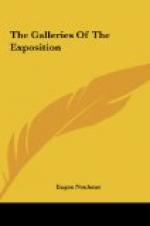Very modestly tucked away and surrounded by art of the few remaining neutral nations, in a small gallery adjoining Holland and Sweden, Germany unofficially and probably even without her knowledge is represented by a small group of pictures which after many adventures reached the hospitable shores of California. Originally exhibited at the last Carnegie Institute Exhibition at Pittsburgh, they found themselves on the high seas on their return voyage at the beginning of the war, only to be captured by an English cruiser whose captain was so painfully struck by the undeniable evidences of German Kultur that instead of taking them to England he returned them to the United States, to be included eventually in our exhibition. It would be very wrong to generalize upon the standard of German art from this small display, but a number of these pictures can well afford to go entirely upon their own merit.
Zügel’s cattle picture is a canvas of the first order, by one of the very important modern animal painters, a man whose fame has penetrated into all lands where art is at all cultivated. The silvery light of a summer morning, filtering through overhanging willow-trees upon the backs of a few Holstein cows, is full of life and admirably loose in its treatment. Above Zügel, Leo Putz, another Munich man, has a lady near a pond, broadly painted, and executed in the peculiar Putz method of square, mosaic-like paint areas which melt into a soft harmony of tender grays and greens. Stuck’s “Nocturne” is affected and unconvincing and scarcely representative of this master’s style. The many other men give a good account of themselves, particularly Curt Agthe, whose classic “Nude at the Spring” is of wonderful surface quality. Wenk has an Italian marine and Benno Becker a landscape from the same country. Göhler’s “Castle Terrace” has a particularly fine sky and a true rococo atmosphere. Hans von Volkmann’s “Field of Ripe Grain” is typical of this Karlsruhe painter, whose stone lithographs have given German art a unique place in the art world.
The United States
Almost one-third of the entire Fine Arts Palace is occupied by the art of the United States, and considering the privileges it enjoys, we have no reason to offer any excuses. One thing should be said, a fact which must force itself immediately upon any careful observer — that we have been very hospitable to the foreign nations at the loss of our own physical comfort. The growing demand from some of the foreign nations for more space than originally applied for has crowded the American section in some instances into rather uncomfortable conditions. On the other hand we do not seem to have acquired such attractive ways of hanging our pictures as the Swedes, Hollanders, or Italians practice; probably for lack of funds. At any rate the American section looks very businesslike and very democratic, without all the frills and fancies of other nations, where every psychological advantage has been taken in order to make things palatable. We have even been criticized for our lack of spaciousness in hanging, but let us not grieve over this, since it does at least save steps in walking from one picture to the next.




